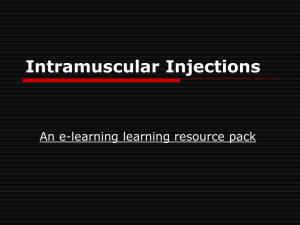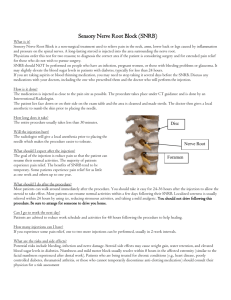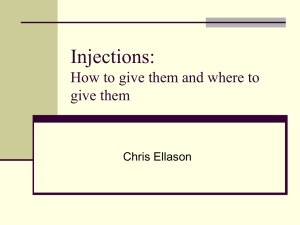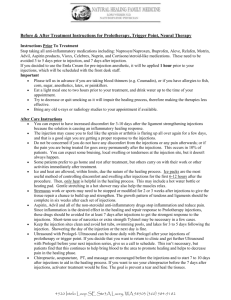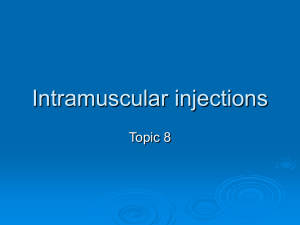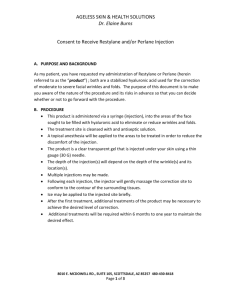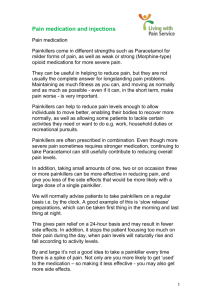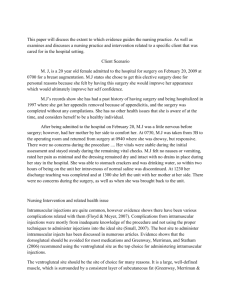Z-tract - ND Center for Nursing
advertisement
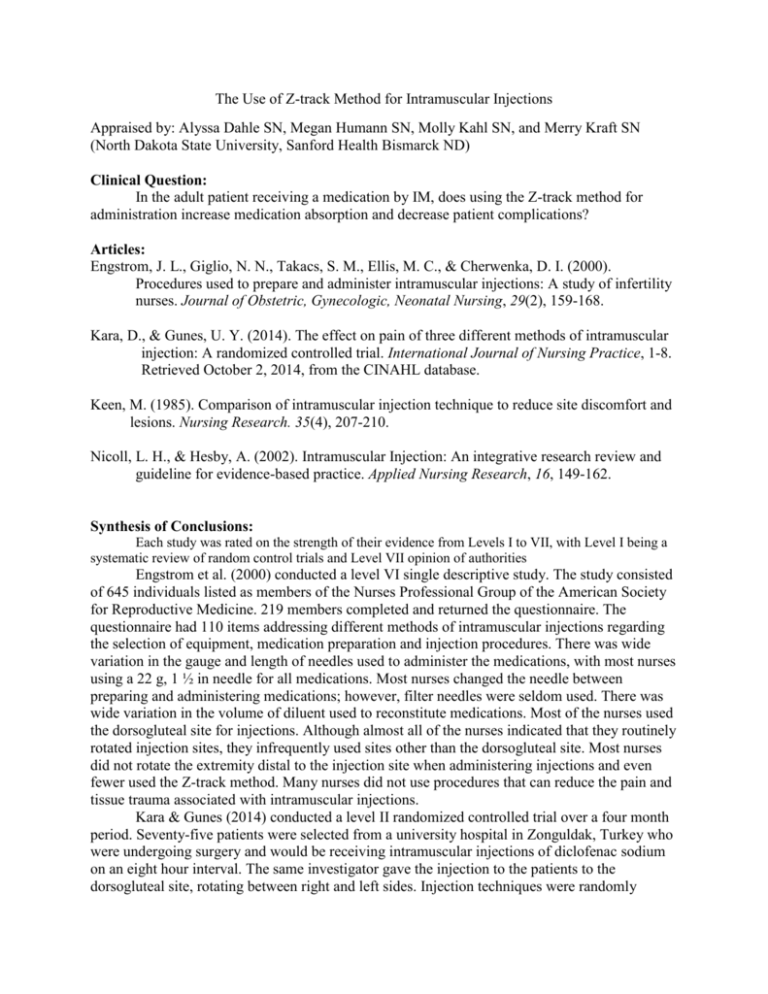
The Use of Z-track Method for Intramuscular Injections Appraised by: Alyssa Dahle SN, Megan Humann SN, Molly Kahl SN, and Merry Kraft SN (North Dakota State University, Sanford Health Bismarck ND) Clinical Question: In the adult patient receiving a medication by IM, does using the Z-track method for administration increase medication absorption and decrease patient complications? Articles: Engstrom, J. L., Giglio, N. N., Takacs, S. M., Ellis, M. C., & Cherwenka, D. I. (2000). Procedures used to prepare and administer intramuscular injections: A study of infertility nurses. Journal of Obstetric, Gynecologic, Neonatal Nursing, 29(2), 159-168. Kara, D., & Gunes, U. Y. (2014). The effect on pain of three different methods of intramuscular injection: A randomized controlled trial. International Journal of Nursing Practice, 1-8. Retrieved October 2, 2014, from the CINAHL database. Keen, M. (1985). Comparison of intramuscular injection technique to reduce site discomfort and lesions. Nursing Research. 35(4), 207-210. Nicoll, L. H., & Hesby, A. (2002). Intramuscular Injection: An integrative research review and guideline for evidence-based practice. Applied Nursing Research, 16, 149-162. Synthesis of Conclusions: Each study was rated on the strength of their evidence from Levels I to VII, with Level I being a systematic review of random control trials and Level VII opinion of authorities Engstrom et al. (2000) conducted a level VI single descriptive study. The study consisted of 645 individuals listed as members of the Nurses Professional Group of the American Society for Reproductive Medicine. 219 members completed and returned the questionnaire. The questionnaire had 110 items addressing different methods of intramuscular injections regarding the selection of equipment, medication preparation and injection procedures. There was wide variation in the gauge and length of needles used to administer the medications, with most nurses using a 22 g, 1 ½ in needle for all medications. Most nurses changed the needle between preparing and administering medications; however, filter needles were seldom used. There was wide variation in the volume of diluent used to reconstitute medications. Most of the nurses used the dorsogluteal site for injections. Although almost all of the nurses indicated that they routinely rotated injection sites, they infrequently used sites other than the dorsogluteal site. Most nurses did not rotate the extremity distal to the injection site when administering injections and even fewer used the Z-track method. Many nurses did not use procedures that can reduce the pain and tissue trauma associated with intramuscular injections. Kara & Gunes (2014) conducted a level II randomized controlled trial over a four month period. Seventy-five patients were selected from a university hospital in Zonguldak, Turkey who were undergoing surgery and would be receiving intramuscular injections of diclofenac sodium on an eight hour interval. The same investigator gave the injection to the patients to the dorsogluteal site, rotating between right and left sides. Injection techniques were randomly selected, between technique A, the patient in the prone position with his or her toes pointing down, technique B, the patient in prone position with one foot internally rotated, and technique C, the patient in prone position with his or her toes pointing down, using the Z-track technique. The pain intensity was measured by a visual analogue scale (VAS). Kara & Gunes (2014) found that technique B (internally rotated foot) measured the least amount of pain intensity. Limitations of the study included: postoperative pain obscuring the pain intensity from the intramuscular injection, the three techniques were administered by the same investigator, and the sample size was small and more studies on larger samples should be researched. Keen (1986) conducted a level II randomized control study consisting of fifty subjects who were 13 female, 37 male. Thirty were African American and twenty were Caucasian and excluded any other race. The ages ranged from 21 to 57 years old. Subjects were all inpatients on selected medical and surgical units of a university medical center hospital. The intervention was using the Z-track method in IM injections and using the standard method technique in IM injections to determine which one caused more pain and lesions. The patients were assigned to random treatment groups A and B. Treatment group A received the Z-track technique and treatment B received the standard technique. The researchers recorded the data using measurement tools such as, the four point Likert scale, discomfort questionnaire and site lesions were measured by the nurses using a scale of severity. They tabulated the data to determine the incidence of discomfort and lesions within four time intervals and both techniques were compared. The study showed the Z-track technique does not decrease the initial pain at the injection site but instead the Z-track method affects the discomfort secondary to leakage and deposition of the injected tissue into the subcutaneous tissue. The level V systematic literature review conducted by Nicoll & Hesby (2002) addressed the proper administration of IM injections in the clinical setting. The purpose of this review was to establish an evidenced based clinical guideline for safe administration of intramuscular administrations that would improve patient outcomes and reduce errors. The study showed that use of the Z-track technique reduced leakage of medication into the subcutaneous space and resulted in less discomfort for the patient and decreased incidence of lesions at the injection site. The review consistently showed that in two out of three studies, the technique of leaving an air bubble in the syringe when administering an IM injection, showed no benefit to the patient. The quality and strength of this study was compromised due to the lack of inclusion and exclusion data, research designs not clearly defined, and the number of participants in each study was not addressed. The quality of this systematic review was fair because it reported the findings of descriptive and qualitative studies, but did not integrate the information to draw comparative conclusions. A research based guideline was developed based on the review, but the study identified that there are many areas that need further research in regards to intramuscular injections. Clinical Bottom Line: A strength of three studies reviewed was that they had large sample sizes, which provided sufficient power to detect statistically significant results. Two of the studies were random controlled trials contraindicating each other. Keen (1985) stated that the Z-track method may not decrease the initial discomfort but decreases the secondary discomfort to medication leakage into the subcutaneous tissue. Kara (2014) stated that having the patient internally rotating their foot is more effective in pain reduction than using the Z-track method. Another study, Engstrom et al. (2000) was a descriptive study that showed many nurses did not use procedures that can reduce the pain and tissue trauma associated with intramuscular injections. The last study was a systemic review of literature by Nicoll & Hesby (2002) that showed that use of the Z-track technique reduced leakage of medication into the subcutaneous space and resulted in less discomfort for the patient and decreased incidence of lesions at the injection site. Three out of the four studies concluded that the Z-track method was beneficial in increasing medication absorption and decreasing patient complications. Implications for Nursing Practice: The evidence from three out of the four studies supports the use of the Z-track method when administering intramuscular injections in adult patients. Incorporating the Z-track method during intramuscular injections would provide consistency in medication delivery. The Z-track method would also be effective in reducing pain, tissue trauma, and complications during intramuscular injections.
